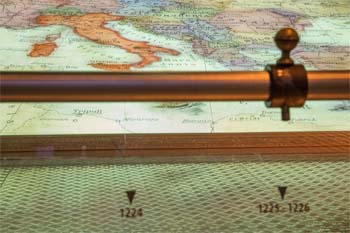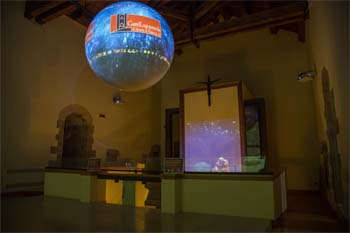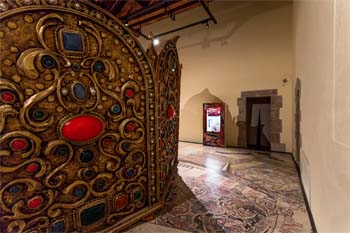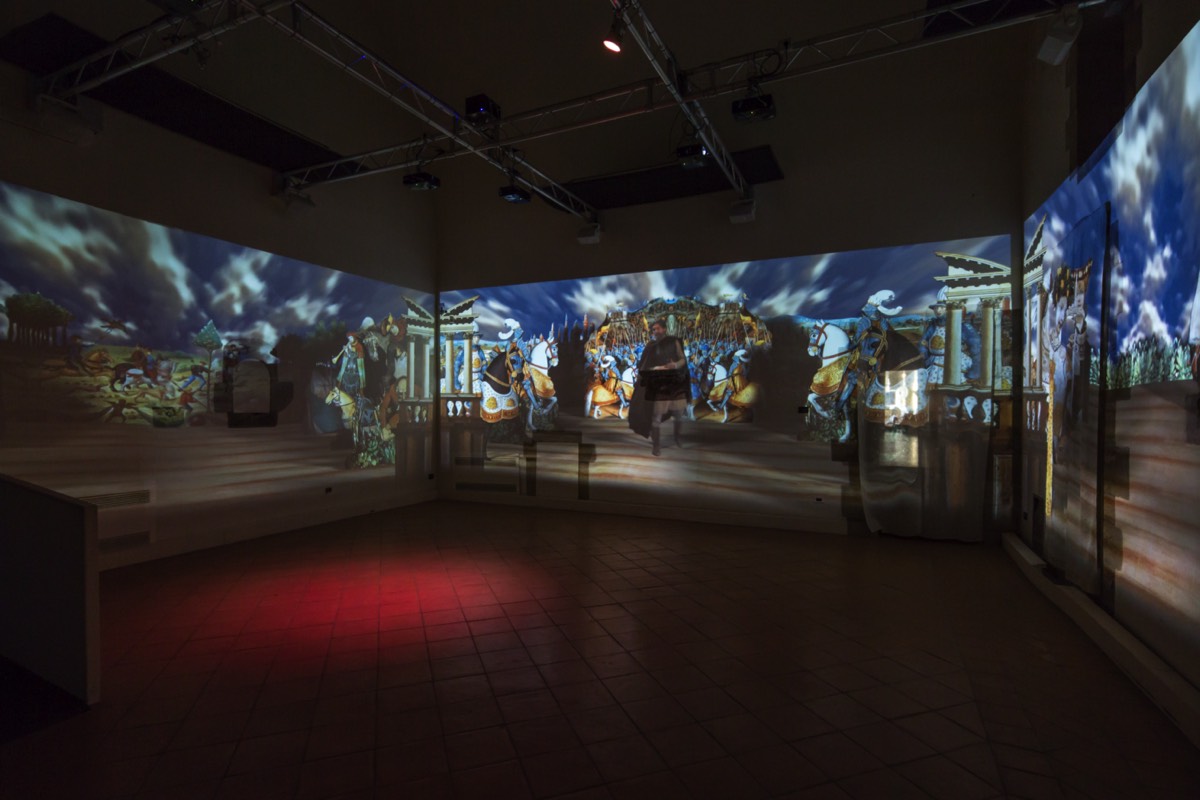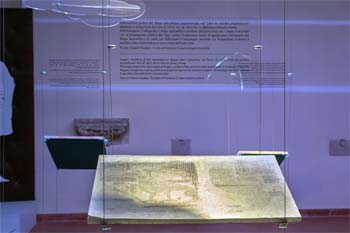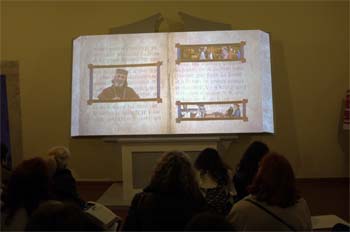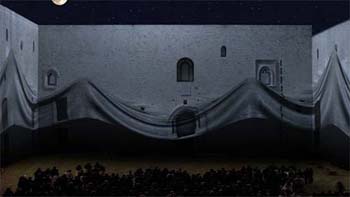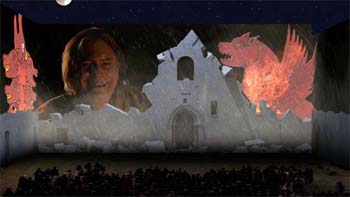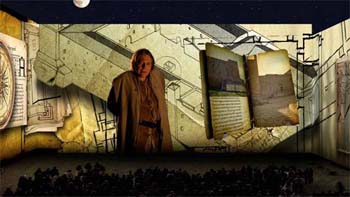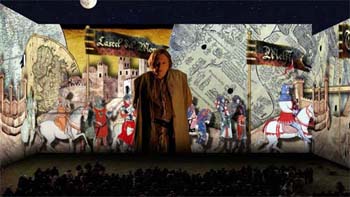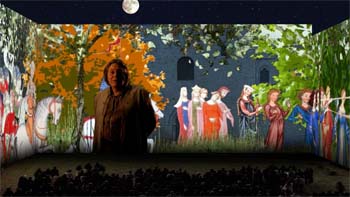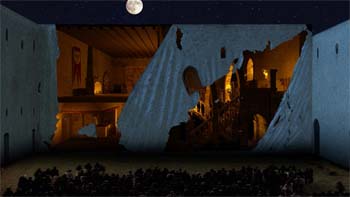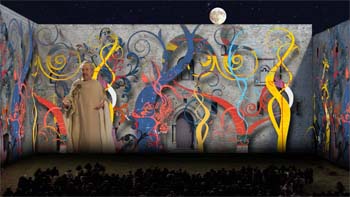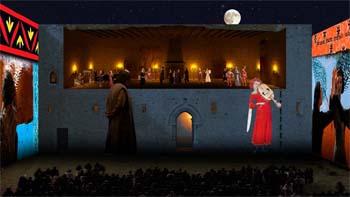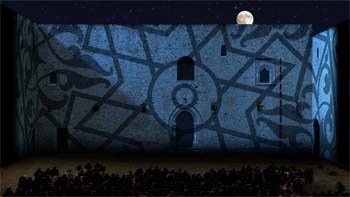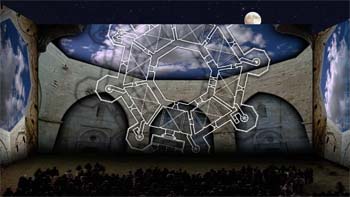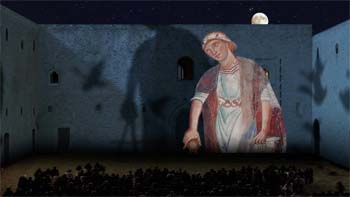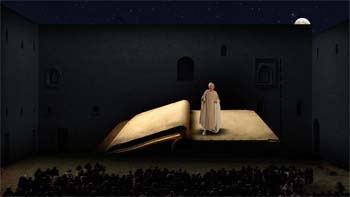Aldo Di Russo
knowing is nothing but an appearance of things on a stage for which "consciousness" supplies the footlights
John Dewey
The world of Frederick II
In the "World of Frederick II", history becomes alive, becomes experience of emotions and knowledge through the performance of multimedia, exhibits and storyline. The visitor experience is divided into two parts: the construction of a narrative museum in the Castle's interior, and the evening performance, based on innovative languages which allow the use of advanced technologies that integrate imaginary scenery to the outstanding performances of the actors of the Italian theater.
The narrative museum is peopling the Castle with stories from the" World of Frederick II". Visitors become integral part of the excitements of the court life, get to know the historical and political events and personalities that marked the Emperor's lifetime. Through an interactive and very atmospheric journey, an exhibition of art and media illuminate the personality of Frederick and his time: the arts, the crafts, the struggle against the pope and his human side as well. In his monologue the Emperor states that he is infiltrated by the desire for perfection, which has been the result of his education. Frederick has devoted his life to bring together through art, culture, government, civil society he boundless "Stupor Mundi", the curiosity about the world. Historic personage and daily life is offered by the visitor itinerary in the narrative museum and a dramatic staging taking place in the courtyard of the Castle with a special effect film. Technology and creativity allow the walls of the Castle to become testimony and reveal what people have seen, heard, imagined, suspected and finally discovered.
The Emperor's Bodyguard

The adventure begins with the visitors climbing the interior stair case. An unusual surprise is awaiting there directly attracting the attention: the Emperor's personal bodyguard is a Arab soldier who emerges from his sleep upon visitor arrival to welcome and invite them to learn by playing. The Emperor does not trust Christians for being his bodyguards because the pope has excommunicated him. The cognitive-emotional experience is triggered in the Globe Room: a narration related to the place and time starts with the animation of the central sphere hanging from ceiling. The historical narration is enriched with icons from codes and miniatures.
The Bar of Time
LOADING
The experience continues with the Bar of Time and the Geographical Map. Visitors can move back and forth in the space and time witnessing the achievements and exploits of the Emperor, using the tangible structure placed opposite of the Geographical Map. The Bar of Time offers 12 significant events in the reign of Frederick accessible via audio installation or headphones in 3 languages. By moving the cursor back and forth visitors acquire freedom to move into the selected historic period. The Geographical Map paper has been antiqued, so that the current borders pass the knowledge where the events occurred. In this way also children and young audiences from different countries may easily recognize their places of origin.
The Crown Hall
LOADING
In the the Crown Hall a large octagonal crown, is dominating the landscape. Buds are set as jewels in the 15*4 meter large crown. The placement of the buds follows the average visitor height, starting low for children to higher for adults all around the crown. Visitors open the buds, where each one is showing several scenes from the life in the castle: the blacksmith, the market place, the doctor, the tavern, scenes of the court. The characters in these scenes are all native Lucans, “direct heirs” of those ancestors, who helped by their sweat and blood that the Emperor’s vision becomes true. Visitors can be informed about backstage information on the production via the touch screen kiosk on the wall.
The Court Hall
LOADING
In the Hall of the Court an immersive and engaging experience is taking place combining theatre and refined technology. A 360-degree projection on the walls presents the Emperor, his last wife, Bianca Lancia and his favorite son, Manfred. The characters share with visitors important aspects of their lives, revealing humaneness and secrets. King Manfred, is full of admiration for his father, who promotes sciences and welfare, wrote in verse and prose. Bianca Lancia, the last of four wives, and the only true love of Frederick, is shown suffering loneliness and jealousy, with a constant hope of getting married.
The Hall of Vestigies
LOADING
The Hall of Vestigies displays Federician documents and invites visitors to play at four interactive stations displaying silhouette patterns , characters and medieval clothing. Multigenrartional audiences are then engaged with the screens of which featuring the personage of the time, including castle ladies, servants, knights and craftsmen. The documentation of exhibits bears solid proof of main historical etappes in the life and work of Frederick, bas-reliefs , codes, chalk, a reproduction of the De arte venandi cum avibus, coins, and icons. The visitor experience is realized through the possibility to become tactile with the exhibits, that are finest reproductions of originals.
The History Book
LOADING
One of the noteworthy interventions is the installation in the Hall of the Temporary Exhibitions which will allow visitors to enjoy living history, through a sophisticated device in the form of a book that gives spirit to new content via the video projection, inspired by the themes dealt in the Court of Frederick. In the Hall are offered temporary exhibitions such as the one on " Medieval Women " or " The faces and places of Frederick II”. Exhibits include knights , helmets and swords and medieval clothing.
Project Mapping Show
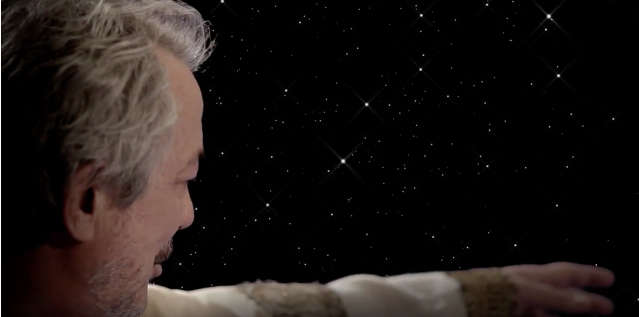
LOADING
The courtyard walls mutate, metamorphose, break up and reshuffle, becoming the background for our historical figures. Magical screens that mix medieval elements, architecture, graphics, history, monologues and surprising special effects. We see the incredulous expression of Gottfried, an emissary of the Pope sent in disguise to spy on the Court. He recounts of the Emperor’s marvels and loves, his daring to challenge the power and his dream to become master of every form of knowledge.
LOADING
The emperor is designing the strategy of his kingdom: culture and art as governance tools. Planning to set up new universities, schools, he calls poets, astronomers, and architects without been prejudiced against culture and faith because knowledge is the starting point of pacific coexistence. Gottfried, on the contrary, put religious credo before discovering, believe before philosophy, prayers before poetry.
LOADING
So spying Frederick and his court he reveal all the buildings, the constitution, the process of living together with three religions in peace and in cooperation. He reveals how the Stupor Mundi has in great consideration the Arab medicine and science, how he puts together Germans and Sicilians, how he forecasts the Mediterranean to be the center of the world.
LOADING
But the spy has been discovered. The archers shot the bird with which he carried his letter to the pope. But Gottfried von Hutten acted in good faith. He joined the court, he lied, he spied, he betrayed his emperor only to serve God, the pope, his religion. In the end, from an ancient book where the author imagines to have found the story, Frederick II, the Stupor Mundi as people say, tells us that his actions were not inspired by power, but by the desire and knowledge, literature and science.
© 2014 Aldo Di Russo contacts




